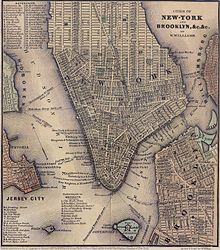New York and Harlem Railroad
 New York and Harlem Railroad (red) and standard gauge |
The New York and Harlem Railroad (now the
The line became part of the
History
The New York and Harlem Railroad was first built from the original
In 1831, when the New York and Harlem Railroad received its
Construction
This section needs additional citations for verification. (February 2013) |

The company was incorporated on April 25, 1831 as the New York and Harlem Railroad, to link New York City with suburban Harlem.[9] Among the company's founders was John Mason, a wealthy banker and president of Chemical Bank who was among the largest landowners in New York City. They decided to build their railroad on the eastern side of Manhattan Island, convinced that it would never be able to compete with steamboat traffic on the Hudson River.
The first section, along
- June 10, 1833 – north along 32nd Street
- May 9, 1834 – north along Murray Hill Tunnel
- October 26, 1837 – north along Yorkville Tunnel
- May 4, 1839 – south along
- September 3, 1842 – north to Williamsbridge
- December 1, 1844 – north to White Plains[11]
- June 1, 1847 – north to Croton Falls
- December 31, 1848 – north to Dover Plains[12]
- January 19, 1852 – north to Albany.
- November 26, 1852 – south along Park Row to Astor House at Park Row and Broadway[10]
- A freight branch was built to Port Morris, following the 1853 purchase of the Spuyten Duyvil and Port Morris Railroad[13] and abandoned late in the 20th century. Parts are still visible.[14]
Between 1847 and 1856, a track was built in Grand Street between Centre Street and Bowery (along with one block on the Bowery) for northbound trains.[15] Southbound trains continued to use the old route.
In 1864 or 1865, a branch was added for trains between downtown and the
Operation and control


As in other
The New York City
In 1864, the railroad was purchased by
On July 2, 1870,
On April 1, 1873, the NY&H leased its freight lines to the
The first electric
Receivership and conversion to bus operation
The
On October 10, 1932, it was leased again, this time to the
An approximation of the route is now traveled by
See also
References
- Railroad History Database
- General News, New York TimesDecember 15, 1863 page 4
- New York TimesDecember 26, 1865 page 8
- Local News in Brief, New York TimesNovember 1, 1871 page 8
- Quicker Surface Transit, New York TimesDecember 6, 1896 page 16
- New York & Harlem Intact for Century, New York TimesMay 25, 1930 page 39
External links
References
- ^ "mta.info | Facts and Figures". web.mta.info. Retrieved January 22, 2016.
- ^ "First Street Car - The John Mason - Wonders and Curiosities of the Railway (1884)". todayinsci.com. Retrieved January 22, 2016.
- ^ Julien Electric Traction Car The Electricall Review, via Google Books
- ^ US patent 384447
- ^ US patent 384580
- ^ a b "History of the Railroad". www.southeastmuseum.org. Retrieved August 10, 2008.
- ^ a b c d e f "Railroad and Local history". www.hvrt.org. Retrieved August 10, 2008.
- ^ "Brewster Railroad History". www.southeastmuseum.org. Retrieved August 10, 2008.
- ^ David T. Valentine (1866). A Compilation of the Existing Ferry Leases and Railroad Grants Made by the Corporation of the City of New York, 1866. Edmund Jones & Company. pp. 345–346.
specifically, the "power to construct a single or double railroad or way from any point on the north bounds of Twenty-third street to any point on the Harlem river...to transport, take, and carry property and persons upon the same by the power and force of steam, of animals, or of any mechanical or other power, or any combination of them..."
- ^ a b c New York and Vicinity Railroad Map from 1860 (BrooklynRail.net)
- ISBN 0-9621206-5-0.
- ISBN 0-9621206-5-0.
- ^ The Harlem Division: New York Central System Historical Society
- ^ Port Morris Branch
- ^ "Railroad Is King". The New York Times. September 24, 1856. p. 2. Retrieved September 3, 2011.
- ^ ISBN 0300055366..
- ^ "Steam Below Forty-Second Street". The New York Times. July 2, 1856. p. 8. Retrieved September 3, 2011.
- ^ "The Harlem Railroad Company vs. The City and Police Commissioners". The New York Times. July 31, 1858. p. 4. Retrieved July 9, 2011.
- ^ "Madison Avenue Railway". The New York Times. July 3, 1870. p. 5. Retrieved July 9, 2011.
- ^ "New-York's First Electric Car". The New York Times. September 18, 1888. p. 8. Retrieved July 9, 2011.
- ^ Carman, Harry James (1919). "The Street Surface Railway Franchises of New York City". Columbia University (Ph.D. thesis). pp. 204–220.
- ^ "American Street Railway Investments". 15. New York: Electric Railway Journal; McGraw Publishing Company. 1908: 237–244.
{{cite journal}}: Cite journal requires|journal=(help)
